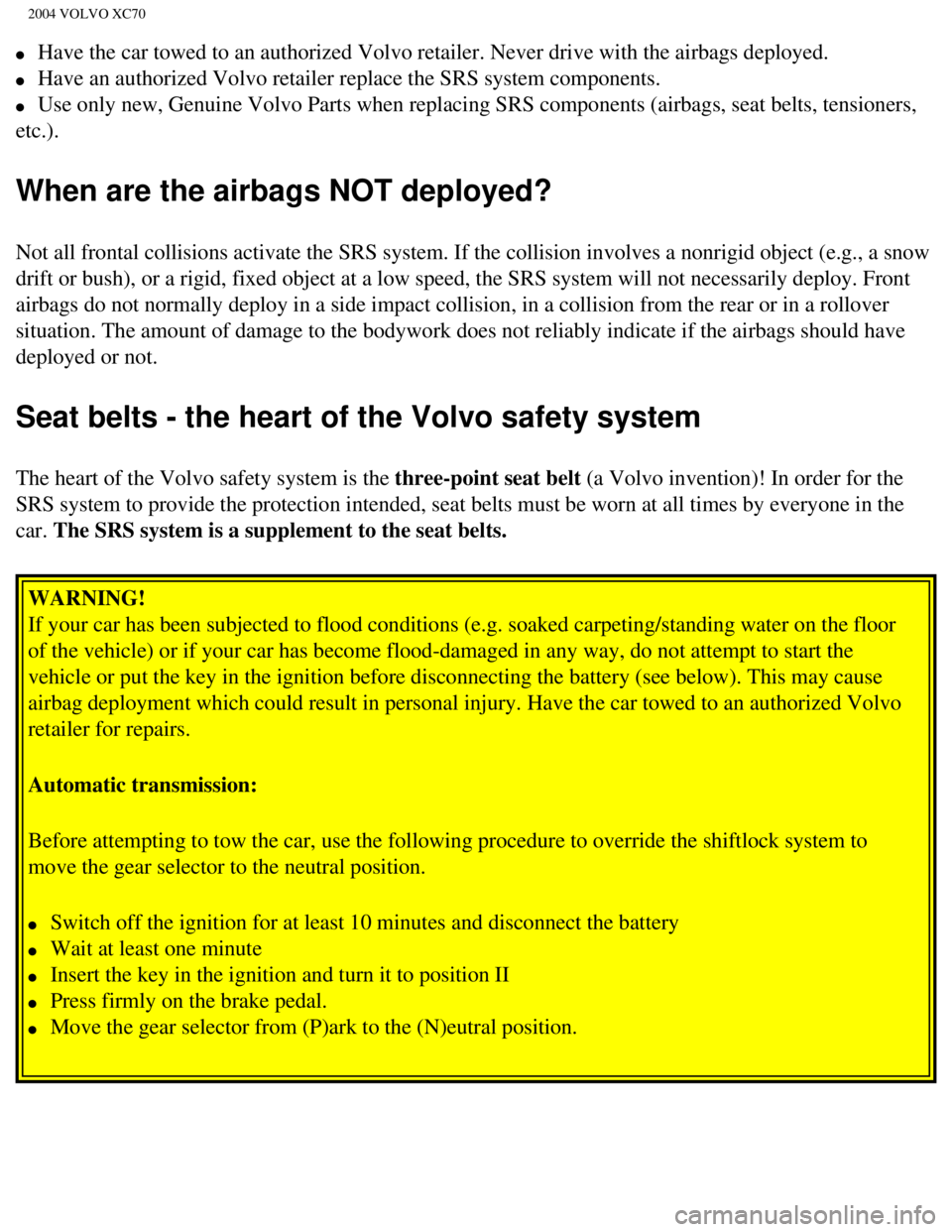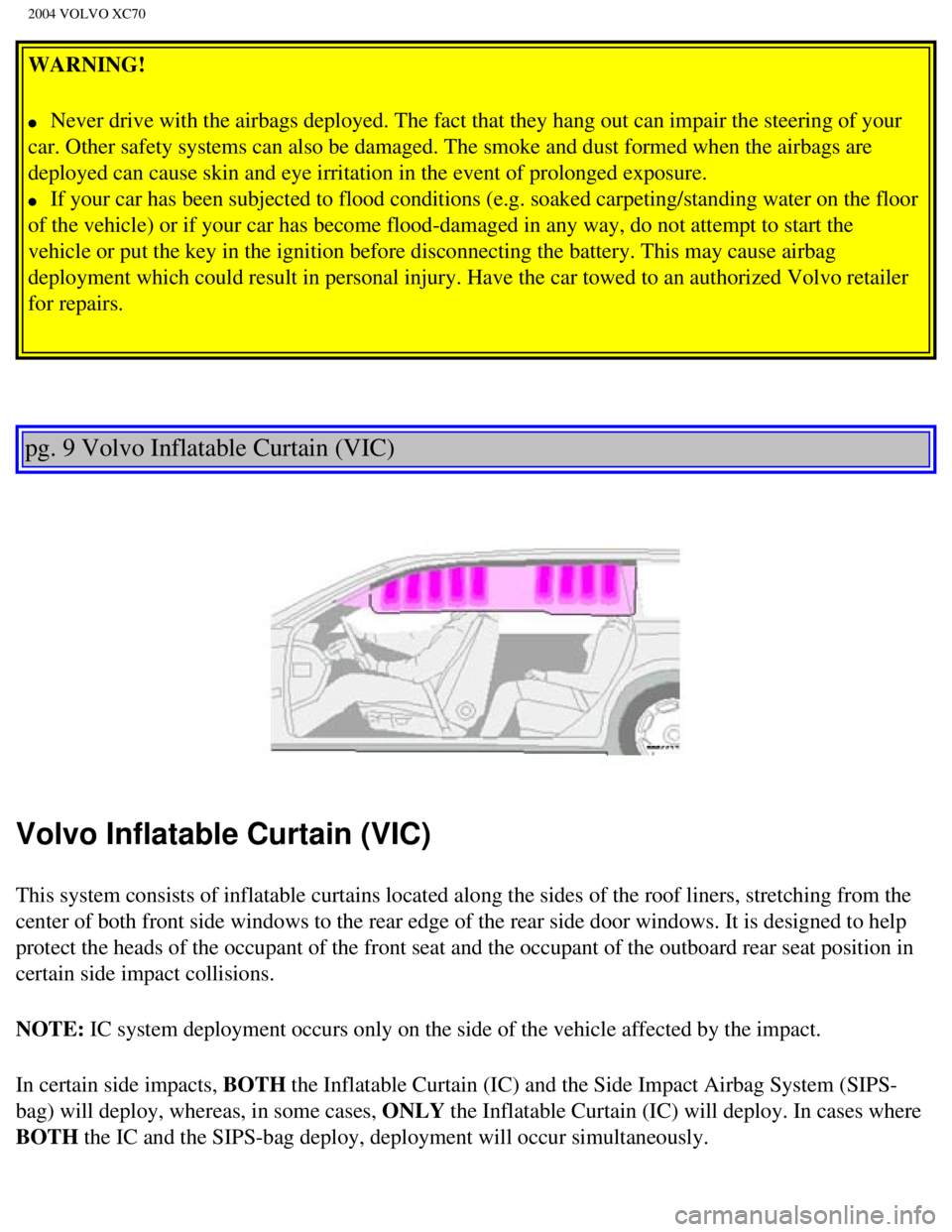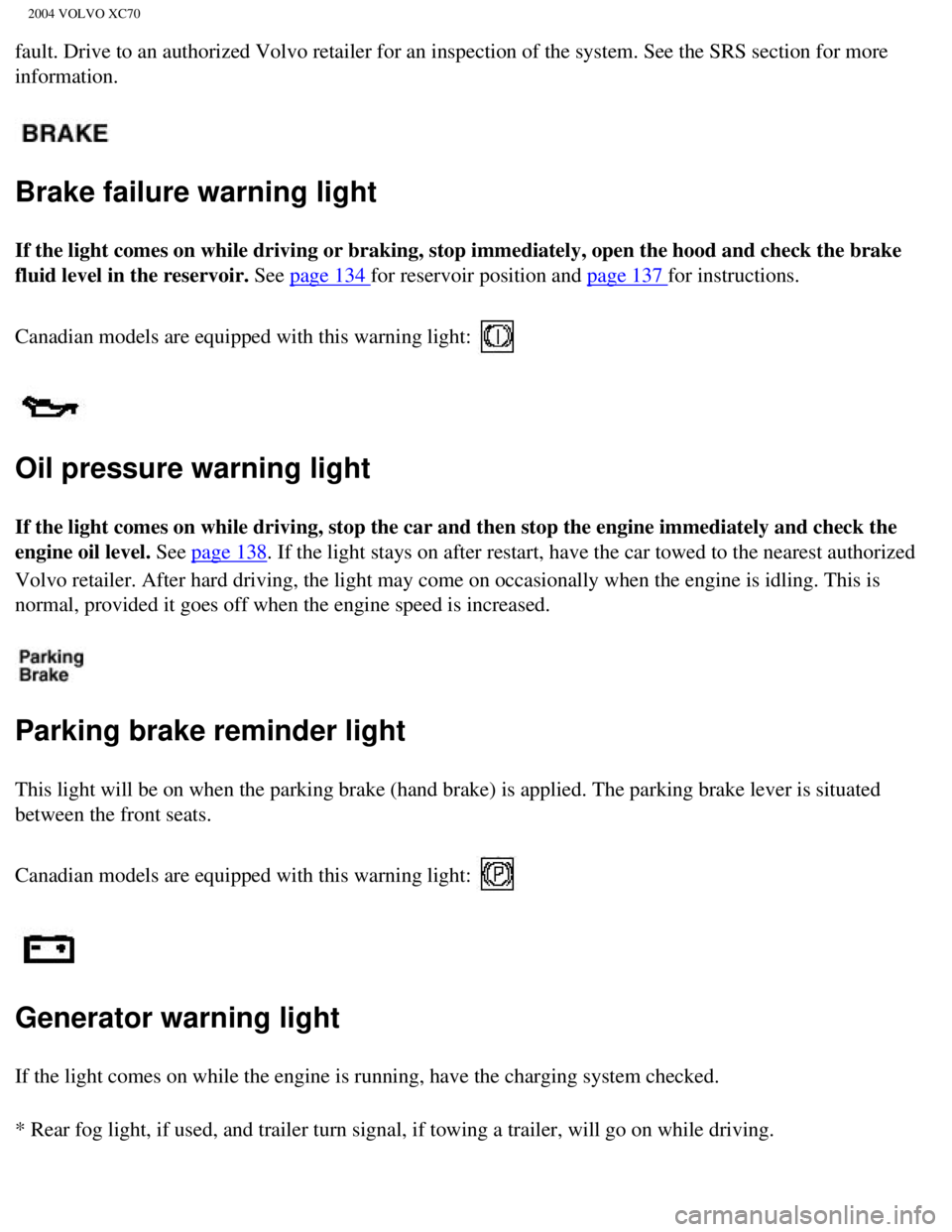tow VOLVO XC70 2004 Owners Manual
[x] Cancel search | Manufacturer: VOLVO, Model Year: 2004, Model line: XC70, Model: VOLVO XC70 2004Pages: 241, PDF Size: 5.78 MB
Page 16 of 241

2004 VOLVO XC70
WARNING!
l Children must never be allowed in the front passenger seat. Volvo recomm\
ends that ALL
occupants (adults and children) shorter than 4 feet 7 inches (140 cm)\
be seated in the back seat of any
vehicle with a passenger-side front airbag. See
page 14 for guidelines.
l Occupants in the front passenger's seat must never sit on the edge of th\
e seat, sit leaning toward the
instrument panel or otherwise sit out of position. The occupant's back m\
ust be as upright as comfort
allows and be against the seat back with the seat belt properly fastened\
.
l Feet must be on the floor, e.g. not on the dash, seat or out of the wind\
ow.
l No objects or accessory equipment, e.g. dash covers, may be placed on, a\
ttached to or installed
near the SRS hatch (the area above the glove compartment) or the area \
affected by airbag deployment
(see illustration on
page 4 ).
l There should be no loose articles, e.g. coffee cups, on the floor, seat \
or dash area.
l Never try to open the SRS cover on the steering wheel or the passenger s\
ide dash. This should only
be done by an authorized Volvo service technician.
l Failure to follow these instructions can result in injury to the vehicle\
occupants.
pg. 7 Front airbags - SRS
NOTE: The information on this page does not pertain to the Side Impact Protect\
ion System airbags.
When are the airbags deployed?
The SRS system is designed to deploy during certain frontal or front-ang\
ular collisions, impacts, or
decelerations, depending on the crash severity, angle, speed and object \
impacted. The SRS sensor is
designed to react to both the impact of the collision and the inertial f\
orces generated by it and to
determine if the intensity of the collision is sufficient for the airbag\
s to be deployed.
WARNING!
The SRS is designed to help prevent serious injury. Deployment occurs ve\
ry quickly and with
considerable force. During normal deployment and depending on variables \
such as seating position,
one may experience abrasions, bruises, swellings, or other injuries as a\
result of airbag(s) deployment.
If the airbags have been deployed, we recommend the following:
file:///K|/ownersdocs/2004/2004_XC70/04xc70_01a.htm (10 of 17)12/30/20\
06 4:32:54 PM
Page 17 of 241

2004 VOLVO XC70
l Have the car towed to an authorized Volvo retailer. Never drive with the\
airbags deployed.
l Have an authorized Volvo retailer replace the SRS system components.
l Use only new, Genuine Volvo Parts when replacing SRS components (airbag\
s, seat belts, tensioners,
etc.).
When are the airbags NOT deployed?
Not all frontal collisions activate the SRS system. If the collision inv\
olves a nonrigid object (e.g., a snow
drift or bush), or a rigid, fixed object at a low speed, the SRS system\
will not necessarily deploy. Front
airbags do not normally deploy in a side impact collision, in a collisio\
n from the rear or in a rollover
situation. The amount of damage to the bodywork does not reliably indica\
te if the airbags should have
deployed or not.
Seat belts - the heart of the Volvo safety system
The heart of the Volvo safety system is the three-point seat belt (a Volvo invention)! In order for the
SRS system to provide the protection intended, seat belts must be worn a\
t all times by everyone in the
car. The SRS system is a supplement to the seat belts.
WARNING!
If your car has been subjected to flood conditions (e.g. soaked carpeti\
ng/standing water on the floor
of the vehicle) or if your car has become flood-damaged in any way, do \
not attempt to start the
vehicle or put the key in the ignition before disconnecting the battery \
(see below). This may cause
airbag deployment which could result in personal injury. Have the car to\
wed to an authorized Volvo
retailer for repairs.
Automatic transmission:
Before attempting to tow the car, use the following procedure to overrid\
e the shiftlock system to
move the gear selector to the neutral position.
l Switch off the ignition for at least 10 minutes and disconnect the batte\
ry
l Wait at least one minute
l Insert the key in the ignition and turn it to position II
l Press firmly on the brake pedal.
l Move the gear selector from (P)ark to the (N)eutral position.
file:///K|/ownersdocs/2004/2004_XC70/04xc70_01a.htm (11 of 17)12/30/20\
06 4:32:54 PM
Page 20 of 241

2004 VOLVO XC70
WARNING!
l Never drive with the airbags deployed. The fact that they hang out can i\
mpair the steering of your
car. Other safety systems can also be damaged. The smoke and dust formed\
when the airbags are
deployed can cause skin and eye irritation in the event of prolonged exp\
osure.
l If your car has been subjected to flood conditions (e.g. soaked carpeti\
ng/standing water on the floor
of the vehicle) or if your car has become flood-damaged in any way, do \
not attempt to start the
vehicle or put the key in the ignition before disconnecting the battery.\
This may cause airbag
deployment which could result in personal injury. Have the car towed to \
an authorized Volvo retailer
for repairs.
pg. 9 Volvo Inflatable Curtain (VIC)
Volvo Inflatable Curtain (VIC)
This system consists of inflatable curtains located along the sides of t\
he roof liners, stretching from the
center of both front side windows to the rear edge of the rear side door\
windows. It is designed to help
protect the heads of the occupant of the front seat and the occupant of \
the outboard rear seat position in
certain side impact collisions.
NOTE: IC system deployment occurs only on the side of the vehicle affected by \
the impact.
In certain side impacts, BOTH the Inflatable Curtain (IC) and the Side Impact Airbag System (SIPS-\
bag) will deploy, whereas, in some cases, ONLY the Inflatable Curtain (IC) will deploy. In cases where
BOTH the IC and the SIPS-bag deploy, deployment will occur simultaneously.
file:///K|/ownersdocs/2004/2004_XC70/04xc70_01a.htm (14 of 17)12/30/20\
06 4:32:54 PM
Page 33 of 241

2004 VOLVO XC70
motor vehicle safety from the Hotline.
Volvo strongly recommends that if your vehicle is covered under a servic\
e campaign, safety or emission
recall or similar action, it should be completed as soon as possible. Pl\
ease check with your local retailer
or Volvo Cars of North America, LLC. if your vehicle is covered under th\
ese conditions.
NHTSA can be reached at:
Internet :
http://www.nhtsa.dot.gov
Telephone:
1-888-DASH-2-DOT (1-888-327-4236) (toll free)
1-800-424-9393 (toll free)
1-202-366-0123 (in Washington DC area)
pg. 18 Brake system
Brake circuit malfunction
The brake system is a hydraulic system consisting of two master cylinder\
s and two separate brake
circuits. If a problem should occur in one of these circuits, it is stil\
l possible to stop the car with the other
brake circuit.
If the brake pedal must be depressed farther than normal and requires gr\
eater foot pressure, the stopping
distance will be longer.
A warning light in the instrument panel will light up to warn the driver\
that a fault has occurred.
If this light comes on while driving or braking, stop immediately and ch\
eck the brake fluid level in the
reservoir.
NOTE: Press the brake pedal hard and maintain pressure on the pedal - do not pump the brakes.
WARNING!
If the fluid level is below the MIN mark in the reservoir: DO NOT DRIVE.\
Tow the car to a Volvo
retailer and have the brake system inspected.
NOTE: When the car is at a standstill and the engine is idling, e.g. at a traf\
fic light and the brake pedal
is depressed, the pedal may go down slightly. This is normal and is caus\
ed by an built-in function in the
power brake system.
file:///K|/ownersdocs/2004/2004_XC70/04xc70_01b.htm (10 of 15)12/30/20\
06 4:32:55 PM
Page 34 of 241

2004 VOLVO XC70
Power brakes function only when the engine is running
The power brakes utilize vacuum pressure which is only created when the \
engine is running. Never let
the vehicle roll to a stop with the engine switched off.
If the power brakes are not working, the brake pedal must be pressed app\
roximately four times harder
than usual to make up for the lack of power assistance. This can happen \
for example when towing your
vehicle or if the engine is switched off when the vehicle is rolling. Th\
e brake pedal feels harder than
usual.
Water on brake discs and brake pads affects braking
Driving in rain and slush or passing through an automatic car wash can c\
ause water to collect on the
brake discs and pads. This will cause a delay in braking effect when the\
pedal is depressed. To avoid
such a delay when the brakes are needed, depress the pedal occasionally \
when driving through rain,
slush etc. This will remove the water from the brakes. Check that brake \
application feels normal. This
should also be done after washing or starting in very damp or cold weath\
er.
Severe strain on the brake system
The brakes will be subject to severe strain when driving in mountains or\
hilly areas or towing. Vehicle
speed is usually slower, which means that the cooling of the brakes is l\
ess efficient than when driving on
level roads. To reduce the strain on the brakes, shift into a lower gear\
and let the engine help with the
braking. Do not forget that, if you are towing a trailer, the brakes wil\
l be subjected to a greater than
normal load.
pg. 19 Anti-lock Brake System (ABS)
Anti-lock Brake System (ABS)
If the warning lamp lights up there is a malfunction of the ABS system (\
the standard braking system will
however function) and the vehicle should be driven cautiously to a Volv\
o retailer for inspection. The
Anti-lock Braking System (ABS) helps to improve vehicle control (stop\
ping and steering) during severe
braking conditions by limiting brake lockup. When the system "senses" im\
pending lockup, braking
pressure is automatically modulated in order to help prevent lockup, whi\
ch could lead to a skid.
The system performs a self-diagnostic test when the engine is started an\
d when the vehicle first
reaches a speed of approximately 12 mph (20 km/h). The brake pedal will pulsate several times and a
sound may be audible from the ABS control module. This is normal.
file:///K|/ownersdocs/2004/2004_XC70/04xc70_01b.htm (11 of 15)12/30/20\
06 4:32:55 PM
Page 35 of 241

2004 VOLVO XC70
To obtain optimal effect from the ABS system, constant pressure should b\
e kept on the brake
pedal, keep constant pressure on the brake pedal. Do not pump the brake \
pedal.
The switching of the ABS modulator will be audible and the brake pedal w\
ill pulsate during braking.
Please be aware that ABS does not increase the absolute braking potentia\
l of the vehicle. While control
will be enhanced, ABS will not shorten stopping distances on slippery su\
rfaces.
ABS with EBD (Electronic Brake Force Distribution)
EBD is an integrated part of the ABS system. EBD regulates the hydraulic\
pressure to the rear brakes to
help provide optimal braking capacity. The brake pedal will pulsate duri\
ng braking, which is normal.
If the BRAKE and ABS warning lights come on at the same time, this could\
indicate a fault in the
brake system.
l Stop the car in a suitable place and switch off the engine.
l Restart the engine.
l If both warning lights go off, no further action is required.
l If both lights are still on after the engine has been restarted, switch \
off the engine again and check the
brake fluid level (see
pages 139 and for the location of the brake fluid reservoir).
WARNING!
If the fluid level is below the MIN mark in the reservoir, DO NOT DRIVE.\
Have the car towed to an
authorized Volvo retailer and have the brake system inspected.
l If the brake fluid level is above the MIN mark, drive carefully to an au\
thorized Volvo retailer and
have the brake system inspected.
pg. 20 STC/DSTC
Stability Traction Control (STC)*/ Dynamic Stability Traction
Control (DSTC)**
* Standard on all models except the T5 turbo and R-models.
** Standard on T5 turbo and R-models, option on all other models
file:///K|/ownersdocs/2004/2004_XC70/04xc70_01b.htm (12 of 15)12/30/20\
06 4:32:55 PM
Page 45 of 241

2004 VOLVO XC70
fault. Drive to an authorized Volvo retailer for an inspection of the sy\
stem. See the SRS section for more
information.
Brake failure warning light
If the light comes on while driving or braking, stop immediately, open t\
he hood and check the brake
fluid level in the reservoir. See
page 134 for reservoir position and page 137 for instructions.
Canadian models are equipped with this warning light:
Oil pressure warning light
If the light comes on while driving, stop the car and then stop the engi\
ne immediately and check the
engine oil level. See
page 138. If the light stays on after restart, have the car towed to the nearest\
authorized
Volvo retailer. After hard driving, the light may come on occasionally w\
hen the engine is idling. This is
normal, provided it goes off when the engine speed is increased.
Parking brake reminder light
This light will be on when the parking brake (hand brake) is applied. \
The parking brake lever is situated
between the front seats.
Canadian models are equipped with this warning light:
Generator warning light
If the light comes on while the engine is running, have the charging sys\
tem checked.
* Rear fog light, if used, and trailer turn signal, if towing a trailer,\
will go on while driving.
file:///K|/ownersdocs/2004/2004_XC70/04xc70_02a.htm (7 of 14)12/30/200\
6 4:32:56 PM
Page 47 of 241

2004 VOLVO XC70
Stability Traction Control (STC) system (option), or Dynamic
Stability and Traction Control (DSTC) system (option)
An indicator light will flash when STC or DSTC is actively working to st\
abilize the car. See pages 20-21 for
more detailed information.
Turn signal indicator - trailer (certain models)
If you are towing a trailer, this light will flash simultaneously with t\
he turn signals on the trailer. If the light
does not flash when signaling, neither the trailer's turn signals nor th\
e car's turn signals are functioning.
Seat belt reminder
This symbol lights up to indicate that the driver has not fastened his/h\
er seat belt.
pg. 30 Text information window
Messages in the text window
When a warning light in the instrument panel comes on, a message is also\
displayed in the text window. After
you have read the message, you can erase it by pressing button A (see i\
llustration above).
file:///K|/ownersdocs/2004/2004_XC70/04xc70_02a.htm (9 of 14)12/30/200\
6 4:32:56 PM
Page 55 of 241

2004 VOLVO XC70
darkness, the daytime running lights will switch off and the Bi-Xenon he\
adlights will switch on.
Parking lights on
Headlights, parking lights, license plate lights and instrument panel i\
llumination are on if the
ignition key is in position II.
If the headlight switch is in position
all lights will go out when the ignition is switched off.
The headlight switch must be in this position before the high beams will\
function (this also applies on
models equipped with the optional Bi-Xenon headlights).
Switch from high to low beams and vice versa by pulling the turn signal \
switch lever on the left side of
steering column toward you.
B - Instrument illumination
Move the thumbwheel up to increase brightness or down to decrease bright\
ness. There is also an
instrument panel illumination sensor (see illustration on
page 48) which automatically adjusts the level
of illumination.
C -Unlocking the fuel filler door
Press this button when the car is at a standstill to unlock the fuel fil\
ler door. Please note that the fuel
filler door will remain unlocked until the car begins to move forward. A\
n audible click will be heard
when the fuel filler door relocks.
See also
page 86.
file:///K|/ownersdocs/2004/2004_XC70/04xc70_02b.htm (3 of 18)12/30/200\
6 4:32:58 PM
Page 58 of 241

2004 VOLVO XC70
A chime will sound if the key is left in the ignition and the driver's d\
oor is opened.
* The gear selector must be in the (P)ark position.
** Please be aware that leaving the key in this position will increase b\
attery drain.
Turn signals
1 Lane change position. In maneuvers such as lane changing, the driver can flash the turn signal\
s by
moving the turn signal lever to the first stop and holding it there. The\
lever will return to the neutral
position when released.
2 Signal lever engaged for normal turns.
3 High beam/low beam switch (headlights on).
Move the lever towards the steering wheel and release it.
Headlight flasher (headlights off).
Move the lever towards the steering wheel. The headlight high beam will \
be on until the lever is
released.
NOTE: If the turn signal indicator flashes faster than normal, check for a bur\
ned-out turn signal bulb.
pg. 37 Windshield/tailgate wipers/washers
file:///K|/ownersdocs/2004/2004_XC70/04xc70_02b.htm (6 of 18)12/30/200\
6 4:32:58 PM